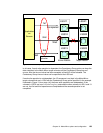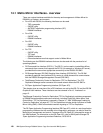
Chapter 13. Metro Mirror options and configuration 143
Figure 13-5 Logical paths
Paths are unidirectional, that is they are defined to operate in either one direction or the other.
Still, Metro Mirror is bidirectional. That is, any particular pair of LSSs can have paths defined
among them that have opposite directions—each LSS holds both source and target volumes
from the other LSS. Moreover, opposite direction paths are allowed to be defined on the
same Fibre Channel physical link.
For bandwidth and redundancy, more than one path can be created between the same LSSs.
Metro Mirror will balance the workload across the available paths between the primary and
secondary LSSs.
Physical links are bidirectional and can be shared by other Metro Mirror pairs, as well as other
remote mirror and copy functions, such as Global Copy and Global Mirror.
13.4.1 Fibre Channel links
A DS6000 Fibre Channel port can simultaneously be:
Sender for Metro Mirror primary.
Receiver for a Metro Mirror secondary.
Target for Fibre Channel Protocol (FCP) hosts I/O from open systems and Linux on
System z.
Although one FCP link would have sufficient bandwidth for most Metro Mirror environments,
for redundancy reasons we recommend configuring two Fibre Channel links between each
primary and secondary disk subsystem.
With the DS6000 you have only eight Fibre Channel ports (FC ports) available, four per
server (controller). And, each sever owns each FC port, unlike the DS8000. Therefore, we
recommend that you use two Fibre Channel links for Metro Mirror,
one on each controller, for
availability and balanced configuration. See Figure 13-6.
Note: Keep in mind that the LSS is not a physical construct in the DS6000; it is a logical
construct. Volumes in an LSS can come from multiple disk arrays.
LSS 0
LSS 3
LSS 1
LSS 2
LSS 08
LSS nn
:
:
Physical
Fibre Channel link
256 logical paths
per FCP link
LSS 0
LSS 3
LSS 1
LSS 2
LSS 08
LSS nn
:
:


















